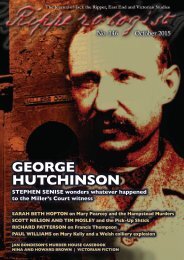Edmund Reid
nuhf574
nuhf574
Create successful ePaper yourself
Turn your PDF publications into a flip-book with our unique Google optimized e-Paper software.
Jack the Ripper: The Facts<br />
Philip Holbrook<br />
Kindle ebook<br />
£1.99<br />
Don’t bother with this book, even if you can download and open it and have the eyesight capable<br />
of reading the tiny print. It’s another rip-off, this time it’s lifted the Wikipedia entry on Jack the<br />
Ripper and lazy Philip Holbrook couldn’t be bothered to disguise the fact. It even includes the same<br />
illustrations. And, perhaps the biggest sin, it pinches the title of my book.<br />
Policing the Victorian Community:<br />
The Formation of the English Provincial Police Forces, 1856-1880<br />
Vol: 9 in the Routledge Library Editions: The History of Crime and Punishment<br />
Carolyn Steedman<br />
London: Routledge and Keegan Paul, 2016<br />
www.routledge.com<br />
First Published: London: Routledge and Keegan Paul, 1984<br />
ISBN: 9781138943728<br />
£90.00 Hardcover/£26.99 ebook<br />
The very hefty price tag means that this isn’t likely to be a book you’ll buy for your personal<br />
library, but it’s one you might want to source from your local library. Also, it’s worth noting that it<br />
was originally published in 1984, so it might not be as up-to-date as you’d like.<br />
As the cover price indicates, this is an academic book, written in an academic style, and<br />
unfortunately for some reason printed in a typewriter typeface that I found frustratingly awkward to read. Nevertheless,<br />
it was and remains an interesting examination of the development of provincial police forces following the passing of<br />
the County and Borough Police Act in 1856, which made it compulsory for any county in England (and Wales) which had<br />
not already established a police force to do so.<br />
The book has two parts, “Government and Policing” and “Men and Policemen”, the latter being a particularly<br />
interesting analysis of the places and occupations from which policemen were recruited, the possible reasons why some<br />
men saw policing as an attractive opportunity, and how and why recruits very often failed to make it through their first<br />
year on the beat.<br />
At first the bulk of recruits were men in their mid-20s, but soon they were in their early-20s, and a good many had<br />
worked the land before joining the police. Farm labourers worked hard for little pay, so police work seemed immediately<br />
attractive, but many found the police to be less appealing than it had first appeared. Roughly half of those who joined<br />
the police survived a year in the job and a mere 12% made it through to receiving their pensions. These figures remained<br />
pretty much the same throughout the period covered by the book. Interestingly, of those who left in their first year, 47%<br />
resigned and 53% were dismissed. The dismissal rate dropped quite dramatically as the years of service increased, but<br />
the chance of dying whilst in harness increased.<br />
What we often overlook is that policemen were almost exclusively working-class, whilst those they policed and over<br />
whom they had to exercise a degree of authority were middle- and upper-class. It was therefore psychologically difficult<br />
for a man to become a policeman, stepping out of his class, and having to deal with people who considered him his social<br />
inferior. It’s something which may have had an unappreciated impact on the Ripper investigation.<br />
I enjoyed this book. I can’t recommend that you rush out and buy it, but if you’re interested in the history of the<br />
police you should certainly see if your local library can source it for you.<br />
Ripperologist 147 December 2015 60




